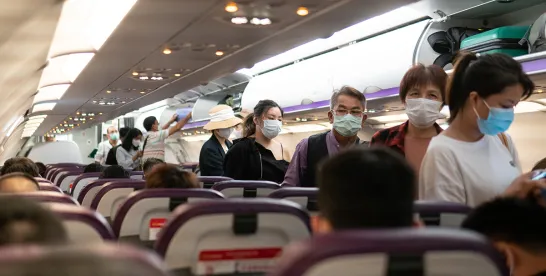With some employees returning to the office, and many states now permitting non-essential business travel, business managers are beginning to reassess the feasibility of a mobile workforce. One barrier to business travel, however, is state by state travel restrictions which vary substantially and may be inconsistent. In addition, the Centers for Disease Control and Prevention (CDC) continues to recommend that employers “minimize non-essential travel,” and offers guidelines for safer business travel during the Coronavirus pandemic.
At the beginning of the Coronavirus pandemic, several southern states, including Florida and Texas, required that all non-essential travelers from select states in the northeast self-quarantine for 14 days upon arrival. With changing infection trends, the states requiring a 14-day quarantine for non-essential travelers upon arrival, or other restrictions, has also changed. Because a quarantine or other travel restrictions may make business travel to and/or from effected states impractical, understanding these regulations is critical to a more mobile workforce. The following table contains a 50-state summary of current non-essential travel restrictions, which are subject to change.
|
State |
Travel Restrictions |
|
Alabama |
Alabama does not have any travel restrictions in place for out-of-state travelers. |
|
Alaska |
Beginning August 11, all out-of-state travelers entering Alaska are required to be tested within 72 hours before arrival; travelers can only enter the state if they test negative. The state is no longer offering tests upon arrival. |
|
Arizona |
Arizona does not have any travel restrictions in place for out-of-state travelers. |
|
Arkansas |
Arkansas does not have any travel restrictions in place for out-of-state travelers. |
|
California |
California does not have any travel restrictions in place for out-of-state travelers. |
|
Colorado |
Colorado does not have any travel restrictions in place for out-of-state travelers. |
|
Connecticut |
On June 25, a mandatory 14-day quarantine was put in place for travelers coming to Connecticut from high-risk states, which you can see here. An executive order has strengthened the travel advisory, making the self-quarantine mandatory and punishable by a fine. The order also requires travelers to fill out a form upon arrival. |
|
Delaware |
Delaware does not have any travel restrictions in place for out-of-state travelers. |
|
Florida |
Florida does not have any travel restrictions in place for out-of-state travelers. |
|
Georgia |
Georgia does not have any travel restrictions in place for out-of-state travelers. |
|
Hawaii |
All travelers arriving at Hawaii’s airports, including residents, must complete the required paperwork. A 14-day self-quarantine applies to all travelers and residents arriving in Hawaii. Beginning October 1, travelers with a valid negative COVID-19 Nucleic Acid Amplification Test (NAAT) issued within 72 hours of travel will no longer need to quarantine upon arrival. If travelers do not present a negative test, they must self-quarantine for 14 days. There is also a 14-day quarantine requirement in place for inter-island travel. This applies to any person arriving to Kauai, Hawaii Island or Maui County (Maui, Molokai, Lanai), and traveling between these islands. It does not include inter-island travelers arriving on Oahu. This requirement is expected to remain in place until September 30. |
|
Idaho |
Idaho does not have any travel restrictions in place for out-of-state travelers. |
|
Illinois |
Illinois does not have any restrictions in place for out-of-state travelers. |
|
Indiana |
Indiana does not have any restrictions in place for out-of-state travelers. |
|
Iowa |
Iowa does not have any restrictions in place for out-of-state travelers. |
|
Kansas |
Travelers arriving in Kansas are requested to quarantine for a period of 14 days starting from the day they arrive in Kansas. All persons arriving in Kansas are required to self-quarantine at home for 14 days if that person traveled to or attended a mass gathering/event outside of Kansas in which 500 or more people were in attendance, on or after August 11. |
|
Kentucky |
As of July 20, Kentucky residents who have traveled to Alabama, Arizona, Florida, Georgia, Idaho, Mississippi, Nevada, South Carolina, or Texas are recommended to self-quarantine for 14 days upon arriving back in Kentucky. Out-of-state travelers from those states are recommended to self-quarantine for 14 days upon arrival in Kentucky. Residents are encouraged not to travel to these states. |
|
Louisiana |
Louisiana has no travel restrictions in place for out-of-state travelers. |
|
Maine |
Visitors entering Maine with proof of a recent negative test result do not have to quarantine upon arrival. Residents of Connecticut, New York and New Jersey are exempt from this requirement altogether. |
|
Maryland |
Maryland strongly recommends that its citizens refrain from non-essential travel outside of Maryland. Travelers should either get tested for COVID-19 promptly upon arrival in Maryland or within 72 hours before travel. Any Marylander who travels to a state with a COVID-19 test positivity rate above 10% should get tested and self-quarantine at home until the test is received. A list of COVID-19 test positivity rates can be found here. The District of Columbia and Virginia are exempt from this recommendation. |
|
Massachusetts |
Beginning August 1, all visitors and residents entering Massachusetts must fill out a travel form and self-quarantine for 14 days, unless arriving from a lower-risk state or can provide a negative COVID-19 test from within 72 hours prior to arrival. |
|
Michigan |
Michigan does not have restrictions in place for out-of-state-travelers. |
|
Minnesota |
Minnesota does not have restrictions in place for out-of-state travelers. |
|
Mississippi |
Mississippi has no travel restrictions in place for out-of-state travelers. |
|
Missouri |
Missouri has no restrictions in place for out-of-state travelers. |
|
Montana |
Montana does not have any travel restrictions in place for out-of-state travelers. |
|
Nebraska |
Only individuals returning to Nebraska from international travel will be required to self-quarantine for 14 days upon arrival. |
|
Nevada |
Nevada has no travel restrictions in place for out-of-state travelers. |
|
New Hampshire |
Travelers from non-New England states for an extended period of time are asked to self-quarantine for a two-week period. |
|
New Jersey |
There is a mandatory 14-day quarantine in place for travelers coming to New Jersey from 33 high-risk states, all of which can be found here. |
|
New Mexico |
All travelers entering New Mexico by air and vehicle are mandated to self-quarantine for 14 days upon arrival. Travel across the southern border to Mexico is restricted to essential travel only. As of August 3, the mandatory self-quarantine does not apply to residents who left the state for medical care, or to residents who left the state for less than 24 hours due to parenting responsibilities. |
|
New York |
There is a mandatory 14-day quarantine in place for travelers coming to New York from many high-risk states, all of which can be found here. Additionally, out-of-state travelers must complete a state Department of Health travel form upon entering New York. Enforcement teams will be stationed at Port Authority and regional airports. |
|
North Carolina |
North Carolina has no travel restrictions in place for out-of-state travelers. |
|
North Dakota |
Travelers entering North Dakota from international locations or other states with widespread COVID-19 transmission must quarantine immediately for 14 days upon arrival. |
|
Ohio |
Individuals diagnosed with COVID-19 or exhibiting symptoms are prohibited from entering Ohio, with a few exceptions. |
|
Oklahoma |
Oklahoma does not have any travel restrictions in place for out-of-state travelers. |
|
Oregon |
Oregon does not have any travel restrictions in place for out-of-state travelers. |
|
Pennsylvania |
Travelers entering Pennsylvania from designated high-risk areas are recommended to self-quarantine for 14 days upon arrival. |
|
Rhode Island |
All travelers entering Rhode Island from designated states with a positivity rate of greater than 5% must self-quarantine for 14 days, unless they can provide proof of a negative test result within 72 hours prior to arrival or during their quarantine period. |
|
South Carolina |
South Carolina does not have any travel restrictions in place for out-of-state travelers. |
|
South Dakota |
South Dakota does not have restrictions in place for out-of-state travelers. |
|
Tennessee |
Tennessee has no travel restrictions in place for out-of-state travelers. |
|
Texas |
Texas does not have any travel restrictions in place for out-of-state travelers. |
|
Utah |
Utah does not have any travel restrictions in place for out-of-state travelers. |
|
Vermont |
All travelers entering Vermont from another state must self-quarantine for 14 days upon arrival, except for persons coming from counties with less than 400 active cases of COVID-19 per one million residents. A list of these counties is here. |
|
Virginia |
Virginia does not have any travel restrictions in place for out-of-state travelers. |
|
Washington |
Washington does not have any travel restrictions in place for out-of-state travelers. |
|
West Virginia |
West Virginia does not have any travel restrictions in place for out-of-state travelers. |
|
Wisconsin |
Statewide travel restrictions have been lifted in Wisconsin, though some local governments have issued their own orders. |
|
Wyoming |
Wyoming does not have any travel restrictions in place for out-of-state travelers. |
In addition, the CDC offers guidelines for safer business travel. Employers should advise employees to check themselves for symptoms of COVID-19 before starting travel and to notify their supervisor and stay home if they are sick. Employers should ensure employees who become sick while traveling or on temporary assignment notify their supervisor and promptly call a healthcare provider for advice, if needed. Finally, Employees should inform employees of any applicable state or local quarantine requirements or other travel restrictions, and instruct employees to adhere to those restrictions. This can be accomplished through periodic updates to return to work policies, which include relevant travel restrictions and guidance for business travel.
As you are aware, things are changing quickly and there is a lack of clear-cut authority or bright line rules on implementation. This article is not intended to be an unequivocal, one-size fits all guidance, but instead represents our interpretation of where things currently and generally stand. This article does not address the potential impacts of the numerous other local, state and federal orders that have been issued in response to the COVID-19 pandemic, including, without limitation, potential liability should an employee become ill, requirements regarding family leave, sick pay and other issues.



 />i
/>i

